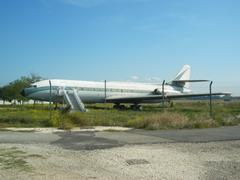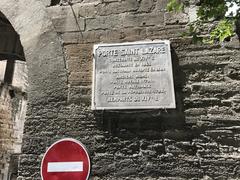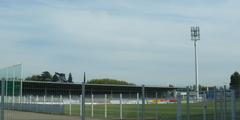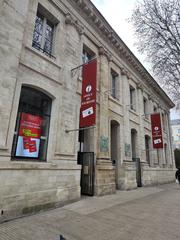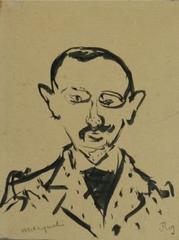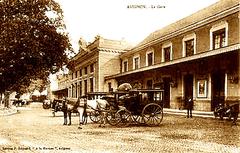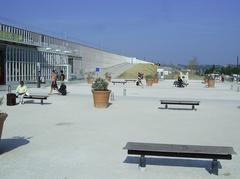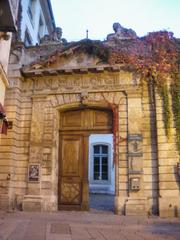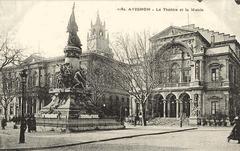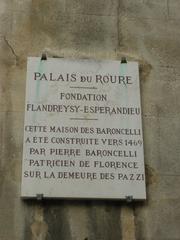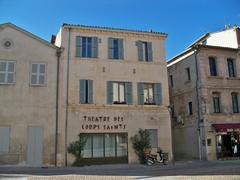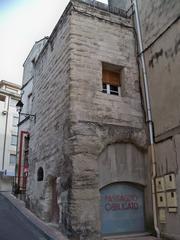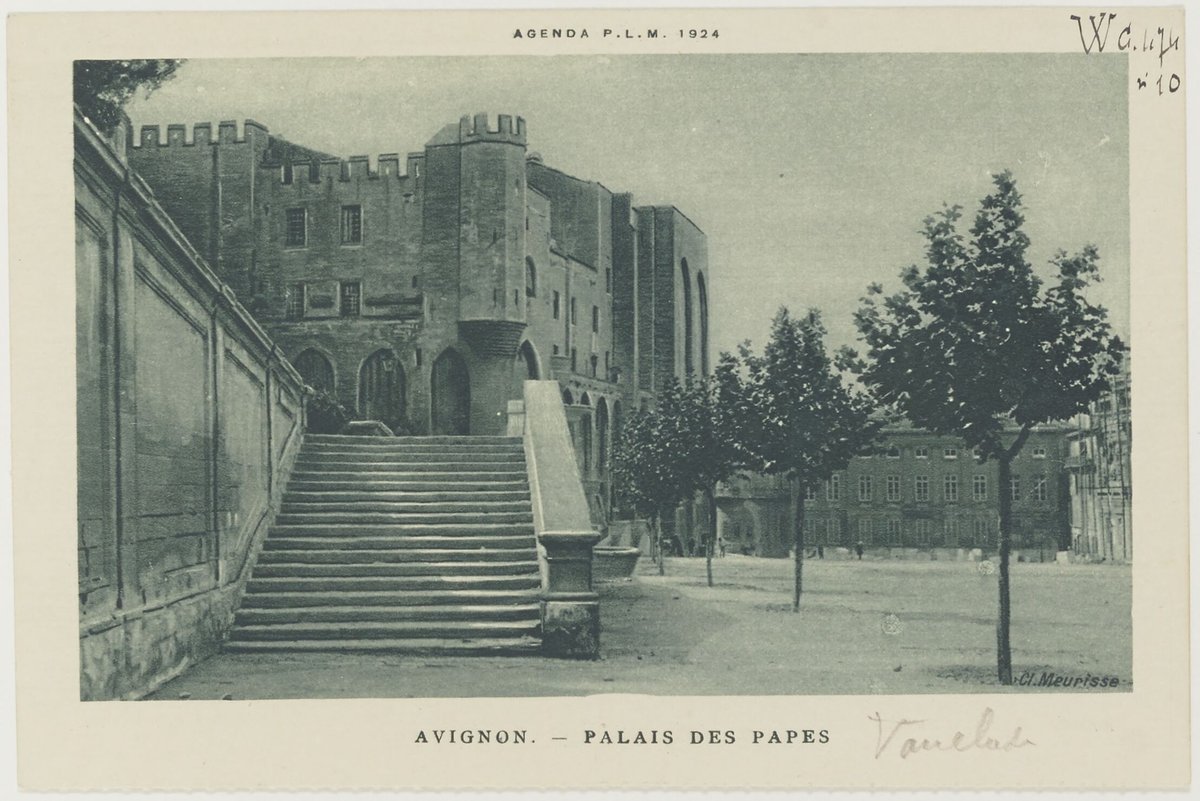
Visiting Hours and Tickets for Palais des Papes
Date: 17/07/2024
Introduction
The Palais des Papes (Palace of the Popes) in Avignon, France, is a monumental example of medieval Gothic architecture and a site of immense historical and cultural significance. Constructed in the 14th century, the palace served as the residence of the popes during the Avignon Papacy, a period that saw the papal court move from Rome to Avignon due to political instability (UNESCO). The palace’s construction was initiated by Pope Benedict XII and expanded under Pope Clement VI, reflecting both the austere and luxurious tastes of its papal inhabitants. Today, the Palais des Papes stands as a UNESCO World Heritage Site, attracting visitors from around the world who come to marvel at its architectural grandeur and delve into its rich history (Britannica). This guide provides a comprehensive overview of the palace’s history, visitor information, travel tips, and key highlights, ensuring a memorable and informative visit.
Table of Contents
History of Palais des Papes
Origins and Construction
The construction of the Palais des Papes began in 1335 and was completed in less than 20 years, a remarkable feat for the time. The palace was built under the direction of two popes, Benedict XII and Clement VI, who sought to create a fortress-like residence that would symbolize the power and influence of the papacy (UNESCO).
The Avignon Papacy
The history of the Palais des Papes is deeply intertwined with the Avignon Papacy (1309-1377), a period during which seven successive popes resided in Avignon rather than Rome. This era began with Pope Clement V, who moved the papal court to Avignon due to the political turmoil in Rome. The relocation was initially intended to be temporary but lasted for nearly 70 years, significantly impacting the political and religious landscape of Europe (Britannica).
Architectural Evolution
The palace’s architecture reflects the evolving needs and tastes of its papal residents. Benedict XII initiated the construction with a focus on fortification, resulting in the Old Palace (Palais Vieux), characterized by its austere and defensive design. His successor, Clement VI, expanded the palace with the New Palace (Palais Neuf), which introduced more elaborate and luxurious elements, including grand halls, chapels, and private apartments (France.fr).
The Great Schism
The Palais des Papes also played a crucial role during the Western Schism (1378-1417), a period of division within the Catholic Church when multiple claimants to the papacy emerged. The schism began after the return of the papacy to Rome, leading to the election of rival popes. Avignon remained a papal stronghold, with antipopes residing in the palace, further complicating the church’s political dynamics (History.com).
Decline and Restoration
Following the end of the Avignon Papacy and the resolution of the Western Schism, the Palais des Papes gradually lost its significance. By the 15th century, it was largely abandoned and fell into disrepair. During the French Revolution, the palace was seized by the state and used as a military barracks and prison, which led to significant damage and neglect (UNESCO).
Modern Era and UNESCO Recognition
In the 20th century, efforts to restore and preserve the Palais des Papes began in earnest. The French government undertook extensive restoration projects to repair the damage and restore the palace to its former glory. In 1995, the Palais des Papes, along with the historic center of Avignon, was designated a UNESCO World Heritage Site, recognizing its historical and architectural significance (UNESCO).
Cultural and Historical Significance
The Palais des Papes is not only a testament to the architectural prowess of the medieval period but also a symbol of the complex interplay between religion and politics in Europe. Its walls have witnessed significant historical events, from the consolidation of papal power to the schisms that threatened to divide the Catholic Church. Today, it stands as a monument to the resilience and enduring legacy of the papacy (France.fr).
Visitor Information
Visiting Hours and Tickets
The Palais des Papes is open to visitors year-round. Typical visiting hours are from 9:00 AM to 7:00 PM, but it is advisable to check the official Avignon Tourisme website for the most current hours and any seasonal variations. Ticket prices range from €12 for adults, with discounts available for students, seniors, and children.
Travel Tips
- Best Time to Visit: Spring and fall are ideal times to visit Avignon to avoid the summer crowds and enjoy mild weather.
- Getting There: Avignon is well-connected by train, with high-speed TGV services from Paris, Marseille, and other major cities. The palace is a short walk from the Avignon Centre train station.
- Accessibility: The Palais des Papes is accessible to visitors with mobility impairments, with ramps and elevators available in key areas.
- Guided Tours: Consider booking a guided tour to gain deeper insights into the history and architecture of the palace.
Nearby Attractions
- Pont Saint-Bénézet: Also known as the Pont d’Avignon, this iconic medieval bridge is a short walk from the Palais des Papes and offers stunning views of the Rhône River.
- Avignon Cathedral: Located next to the palace, the cathedral is another must-visit historical site with beautiful Gothic architecture.
- Place de l’Horloge: The main square in Avignon, filled with cafes, restaurants, and shops, perfect for a leisurely stroll.
Key Highlights
- Grand Chapel: The Grand Chapel, with its soaring ceilings and intricate frescoes, is one of the most impressive spaces within the palace. It served as the main place of worship for the popes and their court.
- Consistory Hall: This hall was used for important meetings and ceremonies, reflecting the administrative and political functions of the papal court.
- Private Apartments: The private apartments of the popes offer a glimpse into their daily lives, with richly decorated rooms and personal chapels.
- Terraces: The palace’s terraces provide stunning views of Avignon and the surrounding countryside, offering a unique perspective on the city’s historical landscape.
Conclusion
The Palais des Papes remains a must-visit destination for history enthusiasts, architecture aficionados, and anyone interested in the rich cultural heritage of France. Its storied past and impressive architecture continue to captivate and inspire visitors from around the world. Plan your visit today and immerse yourself in the history and grandeur of this iconic landmark.
FAQ
Q: What are the visiting hours for the Palais des Papes?
A: The Palais des Papes is typically open from 9:00 AM to 7:00 PM, but it’s best to check the official website for current hours.
Q: How much are tickets to visit the Palais des Papes?
A: Ticket prices are around €12 for adults, with discounts available for students, seniors, and children.
Q: Are there guided tours available?
A: Yes, guided tours are available and highly recommended to gain deeper insights into the palace’s history and architecture.
Q: Is the Palais des Papes accessible to visitors with mobility impairments?
A: Yes, the Palais des Papes has ramps and elevators to accommodate visitors with mobility impairments.
Q: What are some nearby attractions to visit after the Palais des Papes?
A: Nearby attractions include the Pont Saint-Bénézet, Avignon Cathedral, and Place de l’Horloge.
References
- UNESCO. (n.d.). Palais des Papes UNESCO World Heritage Site.
- Encyclopaedia Britannica. (n.d.). Palace of the Popes Britannica.
- France.fr. (n.d.). Palais des Papes France.fr.
- History.com. (n.d.). Western Schism History.com.
- Avignon Tourisme. (n.d.). Palais des Papes Avignon Tourisme.


